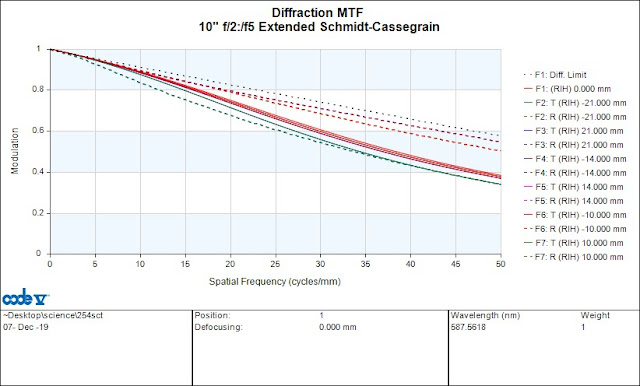Schmidt-Cassegrain Telescopes (SCT's) are incredibly cheap on the secondhand market - 8" OTA's are around $350, 10" (Meade)/11" (Celestron) OTA's under $1000, and even the mighty C14 can be had for under $2000 on good day. Compared to, say, an Ritchey-Chretien telescope (a Cassegrain with a hyperbolic primary) this is an incredible deal - a generic 10" GSO RC sells for about $2500 new and is rarely available on the used market. These low prices are largely due to decades of experience in mass production combined with huge volumes for the visual market.
Unfortunately, if you're interested in photographic rather than visual use, SCT's have traditionally been a questionable choice. SCT's are only corrected on-axis; off axis, they suffer from both coma and field curvature - very severe field curvature at that, thanks to the folded design. Now, RC's (and their relative, the Meade ACF telescopes) are really not that better - they are coma-free, but they replace coma with severe astigmatism and still suffer from field curvature.
Despite the generally poor reputation, the SCT design has a key merit - it uses spherical mirrors. A spherical mirror with a stop placed at the center of curvature has just two aberrations: spherical and coma. This is because the mirror "looks the same" from the point of view of every field angle, so all of the asymmetric aberrations are inherently absent. The Schmidt corrector on an SCT corrects for spherical aberration, which means the only remaining aberration is field curvature, right?
Obviously not, because SCT's are full of coma. This is because the corrector (stop) on a commercial SCT is intentionally moved closer than one radius to the primary in order to shorten the overall length of the system and improve handling. This results in performance like so:
Performance is poor - at the corners of a full-frame field (21mm, about 1 degree), RMS spot sizes reach 108 microns, and this system has virtually no contrast past 10LP/mm (Nyquist for 25um pixels) in the corners.
However, let's move the corrector out to ~660mm from the primary, and add a single concave lens. Performance now looks like this:
Performance is pretty decent, with 21 micron RMS spots in the corners at best average focus, greatly reduced coma, and good contrast even at 50 lp/mm.
The weakly diverging lens (130mm radius of curvature, e.g. Newport KPC067) in front of the image plane serves to cancel out the inherent field curvature of the system and substantially improves performance. It also extends the focal length slightly (from 2500mm to 3000mm), which is not great unless your camera has a KAF-1001E or similar large-pixel sensor. It has the additional disadvantage of adding some chromatic aberration, as it is a singlet with nonzero net optical power - for one-shot color imaging it might be best to just leave it out and accept the field curvature. For narrowband (or even LRGB) imaging, just refocus for each wavelength and it should work fine.
The verdict: yes, it does work. The only other option for correcting an SCT is the Starizona SCT corrector, which is a great product; however, at $599 for the full-frame version it only makes sense on one of the larger instruments. This scheme is obviously more labor intensive - actually implementing it is closer to "build a new telescope using the glass from a commercial SCT" than "modifying a commercially available telescope". Your best bet if you actually build this would be a secondhand C8 ($300), a Chinese focuser ($100) and an a7S ($600 used), a combination which gives a well-corrected ~1 degree field of view.







No comments:
Post a Comment